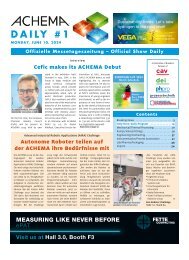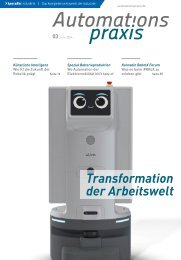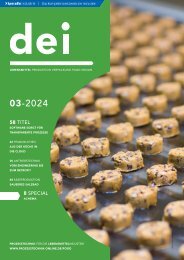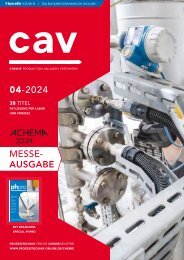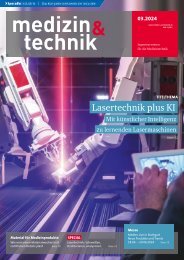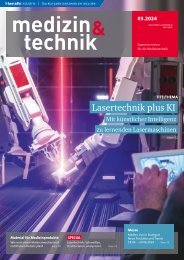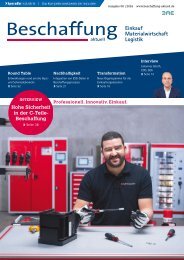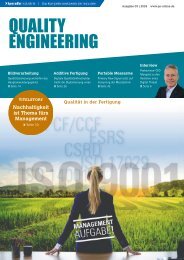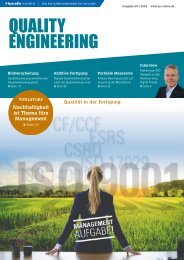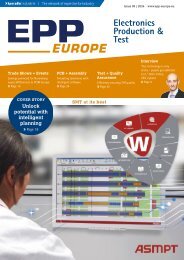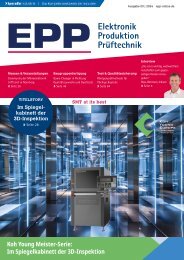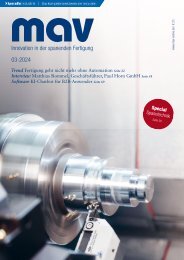cpp – Process technology for the chemical industry 01.2019
The journal cpp - Process technology for the chemical industry reports about processes, plants, apparatus and components for the chemical and pharmaceutical industry. Further topics are IT technologies, industry 4.0, digital production, MSR and automation technology and process analysis technology. The content spectrum is rounded off by explosion protection, plant safety, occupational health and safety, maintenance, site management and energy management.
The journal cpp - Process technology for the chemical industry reports about processes, plants, apparatus and components for the chemical and pharmaceutical industry. Further topics are IT technologies, industry 4.0, digital production, MSR and automation technology and process analysis technology. The content spectrum is rounded off by explosion protection, plant safety, occupational health and safety, maintenance, site management and energy management.
Create successful ePaper yourself
Turn your PDF publications into a flip-book with our unique Google optimized e-Paper software.
Easy access to live data around <strong>the</strong> clock with <strong>the</strong> Vega Inventory System<br />
Bluetooth offers a <strong>for</strong>m of communication<br />
that runs via a separate, second data channel,<br />
making it independent of <strong>the</strong> user<br />
channel. Field devices can thus be analysed<br />
parallel to <strong>the</strong> existing process control without<br />
interfering with plant security and<br />
availability. In <strong>the</strong> future, this local Bluetooth<br />
communication will be expandable to<br />
a complete diagnostic network, allowing<br />
diagnostic access from <strong>the</strong> control room<br />
down to <strong>the</strong> field level, also <strong>for</strong> existing<br />
analogue field devices from Vega. Plant operators<br />
will <strong>the</strong>n be able to react to errors<br />
faster and in a more targeted manner, and<br />
detect deviations in <strong>the</strong> process early by recording<br />
<strong>the</strong> extensive in<strong>for</strong>mation which is<br />
available in <strong>the</strong> field device and taking appropriate<br />
countermeasures.<br />
No more empty bins<br />
Just as flexible in use, although a big step<br />
ahead in terms of digital intelligence, is <strong>the</strong><br />
Vega Inventory System. It offers seamless<br />
status monitoring, providing (or potentially<br />
providing) a database <strong>for</strong> efficient process<br />
supply and automatic re-ordering. The functions<br />
of <strong>the</strong> Vega Inventory System always<br />
follow <strong>the</strong> application. Should <strong>the</strong> supplier<br />
be notified automatically as soon as minimum<br />
stock levels are reached? Is <strong>the</strong> system<br />
“only” meant to visualise <strong>the</strong> course of production<br />
cycles reliably across different periods,<br />
locations and media in order to provide<br />
<strong>the</strong> user with a basis <strong>for</strong> fur<strong>the</strong>r action?<br />
Should it “simply” shorten supply chains to<br />
remote bins and allow query data to be utilised<br />
over long distances? Or is it instead<br />
about integrating inventory directly into an<br />
ERP system? The options and possibilities are<br />
many and varied, and <strong>the</strong>y can be added to at<br />
any time. The free choice of network host is<br />
an advantage <strong>for</strong> security. This task can ei<strong>the</strong>r<br />
be carried out locally by <strong>the</strong> users <strong>the</strong>mselves<br />
or transferred to <strong>the</strong> protected, always up-todate<br />
Vega cloud. “We want to make life easier<br />
<strong>for</strong> our customers, which is why our<br />
measuring instruments function according<br />
to <strong>the</strong> principle of simplicity”, Kaspar continues.<br />
The Vega Inventory System stands <strong>for</strong><br />
minimum ef<strong>for</strong>t and maximum compatibility<br />
<strong>–</strong> with modularity a top priority.<br />
Future standard<br />
It is anything but easy to network field devices<br />
via digital fieldbuses, such as Profibus<br />
PA or Foundation Fieldbus, and <strong>the</strong>n make<br />
<strong>the</strong> analysis and evaluation data available to<br />
<strong>the</strong> control level. Several decades after <strong>the</strong>y<br />
were first introduced, <strong>the</strong>se technologies<br />
have still not succeeded in replacing <strong>the</strong><br />
analogue 4 to 20 mA process signal as <strong>the</strong><br />
most widely used interface <strong>for</strong> level and<br />
pressure measurement <strong>technology</strong> due to<br />
<strong>the</strong>ir high complexity and costs. Bluetooth<br />
is a bridging <strong>technology</strong> that points in <strong>the</strong><br />
right direction within this gap. It mediates<br />
between <strong>the</strong> analogue current interface of a<br />
field device and <strong>the</strong> E<strong>the</strong>rnet-based IT networks<br />
that are standard at almost all companies<br />
today. But why have field devices in<br />
<strong>the</strong> process <strong>industry</strong> not yet been upgraded<br />
<strong>for</strong> direct connection to <strong>the</strong> existing IT infrastructure,<br />
<strong>for</strong> example with an E<strong>the</strong>rnet<br />
interface? The existing two-wire <strong>technology</strong>,<br />
based on <strong>the</strong> 4 to 20 mA interface, has a<br />
decisive point in its favour here: <strong>the</strong><br />
measured value and supply voltage can be<br />
provided simultaneously via just two wires.<br />
In addition, <strong>the</strong>y con<strong>for</strong>m to <strong>the</strong> “intrinsically<br />
safe” type of protection and are also<br />
explosion-proof <strong>for</strong> use in hazardous areas.<br />
The new Advanced Physical Layer (APL)<br />
makes a good alternative. Based on industrial<br />
E<strong>the</strong>rnet <strong>technology</strong>, this intrinsically<br />
safe, two-wire E<strong>the</strong>rnet communication<br />
standard will in future be able to handle demanding<br />
applications in process automation.<br />
The idea is to design it <strong>for</strong> a range<br />
of up to 200 m and a bandwidth of<br />
10 Mbit/s <strong>–</strong> including <strong>the</strong> power supply.<br />
Eleven well-known <strong>industry</strong> partners are<br />
currently involved under <strong>the</strong> umbrella of<br />
Profibus International, with Vega as well as<br />
<strong>the</strong> FieldComm and ODVA organisations<br />
among <strong>the</strong>m. Their common goal is to eliminate<br />
<strong>the</strong> communication bottleneck between<br />
field devices and <strong>the</strong> control level.<br />
Even if several years elapse be<strong>for</strong>e <strong>the</strong> first<br />
APL devices become available in <strong>the</strong> market,<br />
if it is possible to radically simplify <strong>the</strong> setup<br />
and administration of such networks,<br />
this <strong>technology</strong> has <strong>the</strong> potential to become<br />
<strong>the</strong> future standard <strong>for</strong> process automation.<br />
www.<strong>cpp</strong>-net.com<br />
Online search: <strong>cpp</strong>0119vega<br />
AUTHOR:<br />
CLAUDIA HOMBURG<br />
Marketing,<br />
Vega Grieshaber<br />
<strong>cpp</strong> 01-2019 9



